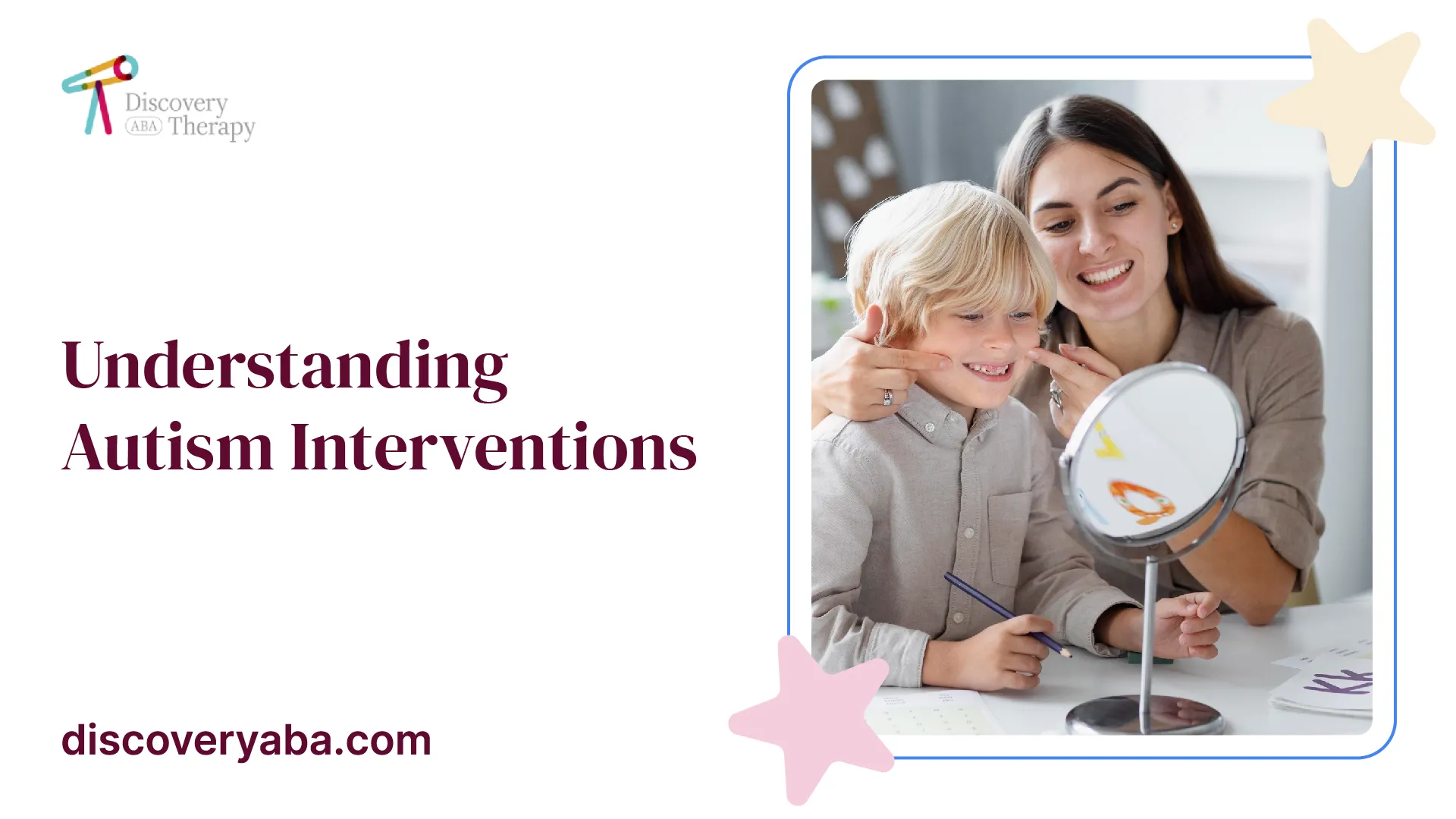Understanding Autism Interventions
In this section, we will explore what autism interventions entail and highlight the importance of effective interventions.
.jpeg)
Autism Interventions
When it comes to supporting individuals with autism, autism interventions play a crucial role in fostering meaningful progress and improving overall quality of life. These interventions encompass a wide range of specialized techniques and approaches designed to address the unique needs of individuals on the autism spectrum.

What Are Autism Interventions?
Autism interventions refer to a diverse set of strategies, therapies, and treatments aimed at enhancing the development, communication, social skills, and daily functioning of individuals with autism. These interventions are tailored to meet the specific challenges and strengths associated with autism spectrum disorder (ASD).
It's important to note that autism interventions are not one-size-fits-all. Each intervention is carefully selected based on the individual's unique needs, goals, and developmental stage. The goal of these interventions is to support individuals with autism in reaching their full potential and achieving greater independence.
Importance of Effective Autism Interventions
Effective autism interventions can have a profound impact on the lives of individuals with autism, enabling them to acquire new skills, improve communication, build social connections, and enhance overall well-being. These interventions are crucial in addressing the core symptoms and challenges associated with autism, such as difficulties in social interaction, communication, sensory processing, and behavior.
By providing structured and evidence-based approaches, effective autism interventions offer individuals with autism the tools they need to navigate the world around them and participate fully in daily life. Early intervention, in particular, has been shown to yield significant benefits in promoting development and reducing the impact of autism-related challenges.
It's important to note that autism interventions should be tailored to the individual's unique needs and preferences. What works for one person with autism may not work for another. By working closely with professionals, such as occupational therapists, speech-language pathologists, and behavior analysts, individuals with autism and their families can identify and implement the most appropriate interventions for their specific circumstances.
These interventions, along with other approaches like early intervention and the use of visual supports, can make a significant difference in the lives of individuals with autism.
Applied Behavior Analysis (ABA)
Overview of ABA
Applied Behavior Analysis (ABA) is a widely recognized and evidence-based approach to autism interventions. It focuses on understanding and modifying behavior to promote meaningful progress in individuals with autism.
ABA utilizes scientific principles of learning and behavior to address various areas of development, including communication, social skills, self-care, and academic skills. The goal is to enhance adaptive behaviors while reducing challenging behaviors.
ABA interventions are tailored to the unique needs of each individual. They are typically implemented by trained professionals, such as behavior analysts or therapists, who work closely with the individual and their family.
Key Components of ABA Interventions
ABA interventions consist of several key components that contribute to their effectiveness:
- Assessment: A comprehensive assessment is conducted to identify the individual's strengths, weaknesses, and specific areas of need. This assessment serves as a basis for developing personalized intervention strategies.
- Targeted Goals: Based on the assessment, specific goals are established to address the individual's needs. These goals are measurable and behaviorally defined, allowing for progress monitoring and evaluation.
- Data Collection: Data collection is a fundamental aspect of ABA interventions. It involves systematically recording and analyzing information about the individual's behavior and progress. This data guides decision-making and helps determine the effectiveness of the intervention strategies.
- Positive Reinforcement: ABA interventions heavily rely on the use of positive reinforcement, which involves providing rewards or preferred items to increase desired behaviors. This approach motivates individuals and encourages them to engage in adaptive behaviors.
- Prompting and Prompt Fading: Prompting is used to assist individuals in acquiring new skills or behaviors. It can range from physical guidance to verbal cues or visual prompts. As the individual becomes more proficient, prompts are gradually faded to promote independence.
- Generalization: ABA interventions aim to promote generalization, which means applying learned skills across different settings, people, and situations. Strategies are implemented to ensure that skills acquired during intervention sessions are transferred to real-life situations.
- Parent Involvement: ABA recognizes the importance of involving parents and caregivers in the intervention process. Collaboration with parents helps reinforce skills and strategies outside of formal therapy sessions, allowing for consistent progress.
By understanding the overview of ABA and its key components, individuals with autism and their families can make informed decisions about incorporating ABA interventions into their comprehensive treatment plan. ABA is just one of the many effective autism interventions available.
Social Skills Training
Importance of Social Skills Training for Individuals with Autism
Social skills training plays a vital role in the development and progress of individuals with autism. As individuals on the autism spectrum often face challenges in social interactions, social skills training aims to equip them with the necessary skills to navigate social situations effectively. By focusing on enhancing social communication, understanding non-verbal cues, and fostering meaningful connections, social skills training can significantly improve the quality of life for individuals with autism.
Developing social skills not only helps individuals with autism to form friendships and establish social connections, but it also enhances their ability to function in different social environments such as school, work, and community settings. Effective social skills training programs provide individuals with the tools and strategies they need to navigate social interactions, express themselves appropriately, and understand the social expectations of different situations.
Through social skills training, individuals with autism can learn how to initiate conversations, maintain eye contact, take turns, interpret facial expressions and body language, and appropriately respond to social cues. These skills are crucial for building relationships, developing empathy, and fostering a sense of belonging. Additionally, social skills training can promote independence and increase opportunities for individuals with autism to actively participate in community activities.
Techniques Used in Social Skills Training
Social skills training incorporates various techniques to teach individuals with autism the necessary social skills. These techniques are designed to address specific difficulties and cater to the unique needs of each individual. Some common techniques used in social skills training include:
- Social Stories: Social stories are short narratives that provide individuals with autism with clear guidelines and expectations for specific social situations. These stories help individuals understand appropriate behaviors, responses, and social norms.
- Role-Playing: Role-playing allows individuals to practice social interactions in a controlled and supportive environment. By role-playing different scenarios, individuals can learn and practice appropriate social skills, such as initiating conversations or problem-solving.
- Video Modeling: Video modeling involves watching videos that demonstrate appropriate social behaviors and interactions. Individuals with autism can observe and imitate these behaviors, helping them understand and learn effective social skills.
- Group Activities: Group activities provide opportunities for individuals with autism to practice social skills in a structured and supportive setting. Group sessions allow individuals to engage in social interactions, practice turn-taking, and learn from their peers.
- Visual Supports: Visual supports, such as visual schedules, social scripts, and visual prompts, can aid individuals with autism in understanding and following social expectations. These visual supports provide additional cues and reminders to support social skill development.
It's important to note that social skills training should be tailored to the individual's needs and abilities. The techniques and strategies used may vary based on the age, developmental level, and specific challenges of each individual. Working with professionals experienced in autism interventions, such as ABA therapists or speech and language therapists, can provide valuable guidance and support in implementing effective social skills training.
By focusing on social skills training, individuals with autism can gain the confidence and abilities needed to navigate social situations successfully, fostering meaningful connections and improving their overall quality of life.
Sensory Integration Therapy
Sensory Integration Therapy is a form of autism intervention that focuses on addressing sensory processing difficulties experienced by individuals with autism. This therapy aims to help individuals effectively process and respond to sensory information from their environment. By improving sensory integration, individuals can enhance their overall functioning and participation in daily activities.
Understanding Sensory Integration Therapy
Sensory Integration Therapy is grounded in the understanding that individuals with autism may have atypical responses to sensory stimuli. This can manifest as hypersensitivity (over-responsiveness) or hyposensitivity (under-responsiveness) to sensory input, such as touch, sound, sight, taste, and smell. These sensory difficulties can impact an individual's ability to engage with their surroundings and may lead to challenges in social interactions, communication, and behavior.
Sensory Integration Therapy aims to address these sensory challenges by providing a structured and therapeutic environment where individuals can engage in activities that help regulate their sensory system. The therapy is typically tailored to the individual's specific sensory needs and preferences.
Approaches and Techniques in Sensory Integration Therapy
Sensory Integration Therapy utilizes a range of approaches and techniques to support individuals with autism in improving their sensory processing abilities. Some common techniques include:
- Therapeutic Play: Engaging in play activities that target specific sensory experiences, such as swinging, jumping, or playing with textured materials, to promote sensory integration.
- Deep Pressure: Applying deep pressure through activities like weighted blankets, compression garments, or firm touch to help individuals regulate their sensory input and reduce sensory sensitivities.
- Proprioceptive Activities: Incorporating activities that provide input to the muscles and joints, such as climbing, pushing, or pulling, to enhance body awareness and coordination.
- Vestibular Stimulation: Using activities that involve movement, such as swinging, spinning, or balance exercises, to stimulate the vestibular system and improve balance, coordination, and sensory processing.
- Visual Supports: Utilizing visual supports, such as schedules, visual cues, or visual timers, to enhance predictability and support individuals in understanding and responding to their environment.
It's important to note that Sensory Integration Therapy should be conducted by qualified professionals who have expertise in this approach. They can evaluate the individual's sensory needs, develop a personalized therapy plan, and guide the implementation of the techniques and activities.
In conjunction with other autism interventions, such as occupational therapy and speech and language therapy, Sensory Integration Therapy can play a valuable role in supporting individuals with autism in their sensory processing difficulties. These interventions work collaboratively to address the unique needs of each individual and promote meaningful progress in their development and daily functioning.
Parent-Mediated Interventions
When it comes to supporting children with autism, parent-mediated interventions play a crucial role in promoting meaningful progress. These interventions involve equipping parents or caregivers with the necessary knowledge and skills to actively engage in their child's development. By empowering parents, these interventions have the potential to create lasting positive impacts on a child's growth and well-being.
Benefits of Parent-Mediated Interventions
Parent-mediated interventions offer several benefits that contribute to a child's overall development. Here are some key advantages:
- Increased Parent Involvement: Through parent-mediated interventions, parents become active participants in their child's therapy journey. This increased involvement fosters a stronger bond between the parent and child, leading to enhanced communication and understanding.
- Consistency and Generalization: Parents are the primary caregivers who interact with their child on a daily basis. By learning intervention techniques, parents can consistently apply strategies across different environments, promoting generalization of skills and behaviors beyond therapy sessions.
- Natural Learning Opportunities: Parent-mediated interventions focus on embedding learning opportunities within everyday routines and activities. This allows children to learn and practice skills in natural, meaningful contexts, enhancing their ability to transfer these skills to real-life situations.
- Support for Individualization: Parents have a deep understanding of their child's unique strengths, needs, and preferences. With guidance from professionals, they can tailor interventions to address their child's specific challenges and capitalize on their strengths.
Examples of Parent-Mediated Interventions
There are various parent-mediated interventions that have shown effectiveness in supporting children with autism. Here are a few examples:
- Pivotal Response Training (PRT): PRT is a naturalistic and child-centered approach that focuses on increasing a child's motivation, initiative, and responsiveness. Parents are trained to identify and capitalize on their child's interests, providing learning opportunities within those preferred activities.
- Early Start Denver Model (ESDM): ESDM is an intervention that combines developmental and behavioral principles to promote early learning in children with autism. Parents are trained to use play-based interactions to support their child's development across various domains, such as social communication, play skills, and cognitive abilities.
- Hanen Programs: Hanen Programs provide parents with strategies to enhance their child's communication skills. These programs emphasize creating rich language environments, using responsive interactions, and promoting joint attention. By incorporating these strategies into everyday interactions, parents can support their child's language development.
Remember, parent-mediated interventions are most effective when implemented in collaboration with professionals who specialize in autism intervention. These professionals can guide parents in understanding and implementing the specific techniques and strategies that best support their child's unique needs.
By embracing parent-mediated interventions, parents can become advocates and active participants in their child's journey towards growth and development. Through their dedication and commitment, parents play a crucial role in creating connections and fostering meaningful progress for children with autism.
Education-Based Interventions
When it comes to autism interventions, education-based approaches play a crucial role in supporting individuals with autism in their learning and development. These interventions focus on providing specialized education programs and individualized support to meet the unique needs of individuals on the autism spectrum. Two key education-based interventions for autism are special education programs and Individualized Education Plans (IEPs).
Special Education Programs for Autism
Special education programs are designed to address the specific learning needs of individuals with autism. These programs provide a structured and supportive environment where individuals can learn and develop academic, social, and life skills. Special education teachers and professionals are trained to effectively support and accommodate the individualized needs of students with autism.
In special education programs for autism, a range of evidence-based teaching strategies and interventions are used. These may include visual supports, structured schedules, task analysis, and individualized instruction. The goal is to create a learning environment that promotes engagement, learning, and progress for individuals with autism.
Individualized Education Plans (IEPs) and Autism
Individualized Education Plans (IEPs) are a key component of education-based interventions for individuals with autism. An IEP is a legally binding document that outlines the educational goals, accommodations, and services required to meet the unique needs of a student with autism. It is developed collaboratively between parents, educators, and other professionals involved in the child's education.
IEPs are tailored to the individual's specific strengths and challenges, providing a roadmap for their educational journey. The plan includes goals and objectives that address academic, social, communication, and behavioral needs. Additionally, it outlines the necessary accommodations, modifications, and support services that will be provided to help the student succeed in the educational setting.
IEPs also encourage collaboration and communication between parents, teachers, and other professionals. Regular meetings and progress monitoring ensure that the plan is effectively implemented and adjusted as needed to support the student's ongoing development.
By utilizing special education programs and developing comprehensive IEPs, individuals with autism can receive the necessary support and accommodations to thrive in their educational journey. These education-based interventions work in conjunction with other interventions such as occupational therapy and speech and language therapy to provide a holistic approach to autism intervention.
Remember, the effectiveness of education-based interventions for autism is greatly enhanced when implemented in a supportive and inclusive environment that values the unique strengths and abilities of individuals on the autism spectrum.
Alternative and Complementary Interventions
When it comes to autism interventions, there are various approaches that can be considered. In addition to evidence-based interventions like Applied Behavior Analysis (ABA), speech and language therapy, and occupational therapy, some individuals and families may explore alternative and complementary interventions. It's important to note that while these interventions may have anecdotal support, the scientific evidence for their effectiveness in improving autism symptoms is limited. However, some individuals may find them helpful in conjunction with evidence-based interventions.
Overview of Alternative and Complementary Interventions
Alternative and complementary interventions refer to a wide range of practices and therapies that are not considered mainstream or evidence-based. These interventions often aim to address the unique needs and challenges faced by individuals with autism. Examples of alternative and complementary interventions include dietary interventions, sensory-based therapies, music therapy, and animal-assisted therapy.
While these interventions may be appealing to some families seeking additional options, it's essential to approach them with caution. It is recommended to consult with healthcare professionals or autism specialists to ensure the safety and appropriateness of these interventions for each individual.
Examples of Alternative and Complementary Interventions for Autism
Here are a few examples of alternative and complementary interventions that some individuals and families may consider:
- Dietary Interventions: Certain dietary interventions, such as gluten-free and casein-free diets, have gained popularity among some individuals with autism and their families. However, the scientific evidence supporting the effectiveness of these diets in improving autism symptoms is limited. It is important to consult with a healthcare professional or a registered dietitian before making any significant dietary changes.
- Sensory-Based Therapies: Sensory integration therapy and other sensory-based interventions aim to address sensory processing difficulties commonly experienced by individuals with autism. These interventions involve engaging individuals in activities that stimulate or regulate their sensory systems, such as deep pressure touch, brushing techniques, or use of weighted blankets. While some individuals may find these interventions beneficial, the evidence supporting their effectiveness is limited.
- Music Therapy: Music therapy involves using music-based interventions to address various needs of individuals with autism. It can help improve communication skills, social interaction, emotional expression, and sensory processing. Music therapists utilize a range of techniques, including singing, playing instruments, and movement to music, to engage individuals and enhance their overall well-being.
- Animal-Assisted Therapy: Animal-assisted therapy involves interactions between individuals with autism and trained therapy animals, such as dogs or horses. These interactions can provide emotional support, improve social skills, and reduce anxiety or stress. However, it's important to note that not all individuals with autism may respond positively to animal-assisted therapy, and further research is needed to fully understand its effectiveness.
It is crucial to approach alternative and complementary interventions with an open mind while considering the available scientific evidence. It is recommended to discuss these options with healthcare professionals or autism specialists to make informed decisions that are best suited for each individual's unique needs. Remember, evidence-based interventions, such as ABA, speech and language therapy, and occupational therapy, remain the foundation of effective autism interventions.
Sources:
Does Your Child Have An Autism Diagnosis?
Learn More About How ABA Therapy Can Help
Find More Articles
Contact us
North Carolina, Tennessee, Nevada, New Jersey, Utah, Virginia
New Hampshire, Maine
Massachusetts, Indiana, Arizona, Georgia
.avif)




































































































